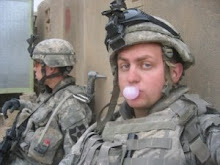If you're not a regular at the Holiday Inn or stopped reading so called news-papers, head on over to USA Today for a piece on veterans opining about The Hurt Locker (including Troy from Bouhammer and yours truly). The word polarizing does not begin to describe the effect the movie has on combat veterans, and I might be the sole dissenter among my former platoon-mates who have showered aspersions on the film via Facebook status updates. I have argued that anyone with combat experience has to sever their intimate knowledge of what it's 'really like' from their mind to have any chance of enjoying contemporary war films. Many cannot undo the inextricable link between their time overseas and what they see portrayed onscreen.
I hate to get zen on anyone, but in these times I turn to the words of Roger Ebert, who has been fond of saying, "A movie is not about what it is about. It is about how it is about it." In other words, the movie isn't just about a trio of EOD techs disarming bombs in Baghdad. It is about how the adrenaline rush of combat and all the danger that comes from the next fix. The most important scene in the movie doesn't come from a bomb defusal or a fiery explosion. It comes from James at home, baffled at life moving at an ordinary, pedestrian, boring pace. How it is about it is contrasting the feeling of home and all the inadequacies that come with it, with subtle yet powerful imagery and incredibly sparse dialogue. That is why the film succeeds where others before it have failed. It is by no means a perfect movie and sacrificed technical accuracy for few genuine and many artificial dramatic scenes, but how it is about its own thesis of war is a drug is why the movie is a landmark in the genre of contemporary war films. In the years to come, there will be many more films about the wars in Iraq and Afghanistan. There will be a handful that are the total package, technically accurate but legitimately and realistically dramatic. Those films will be better than The Hurt Locker, but only because it was there to set the bar far above what we have already seen.
My original review can be found here, and my critique of a review from Big Hollywood can be found here.
I hate to get zen on anyone, but in these times I turn to the words of Roger Ebert, who has been fond of saying, "A movie is not about what it is about. It is about how it is about it." In other words, the movie isn't just about a trio of EOD techs disarming bombs in Baghdad. It is about how the adrenaline rush of combat and all the danger that comes from the next fix. The most important scene in the movie doesn't come from a bomb defusal or a fiery explosion. It comes from James at home, baffled at life moving at an ordinary, pedestrian, boring pace. How it is about it is contrasting the feeling of home and all the inadequacies that come with it, with subtle yet powerful imagery and incredibly sparse dialogue. That is why the film succeeds where others before it have failed. It is by no means a perfect movie and sacrificed technical accuracy for few genuine and many artificial dramatic scenes, but how it is about its own thesis of war is a drug is why the movie is a landmark in the genre of contemporary war films. In the years to come, there will be many more films about the wars in Iraq and Afghanistan. There will be a handful that are the total package, technically accurate but legitimately and realistically dramatic. Those films will be better than The Hurt Locker, but only because it was there to set the bar far above what we have already seen.
My original review can be found here, and my critique of a review from Big Hollywood can be found here.






